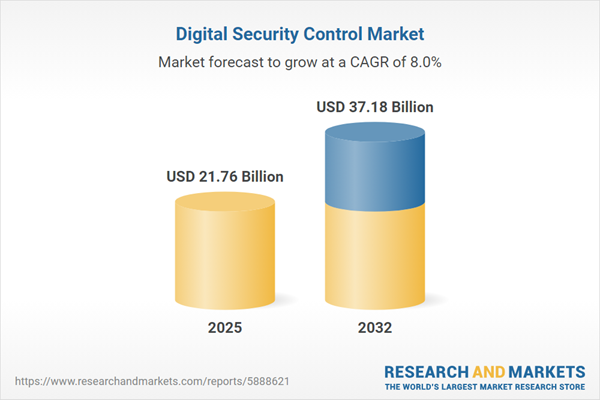Speak directly to the analyst to clarify any post sales queries you may have.
The digital security control market is seeing rapid evolution as enterprises face heightened threats, growing regulatory requirements, and increased operational complexity throughout their digital environments. Senior leaders must proactively strengthen cyber defenses to safeguard business continuity and drive compliance in today’s risk landscape.
Market Snapshot: Digital Security Control Market Overview
The global digital security control market is on an upward trajectory, with its value projected to rise from USD 20.15 billion in 2024 to USD 21.76 billion in 2025 and to reach USD 37.18 billion by 2032, reflecting a compound annual growth rate (CAGR) of 7.95%.
Growth is being accelerated by digital transformation initiatives and the broad adoption of cloud platforms, while remote and hybrid work models are now standard across sectors. Organizations are adopting next-generation security controls to address growing cyber risk and regulatory mandates, ensuring operational resilience on a global scale.Scope & Segmentation: Digital Security Control Market
This report offers senior decision-makers an in-depth analysis of key market segments, supporting informed investment and effective risk management decisions. Rigorous segmentation enables organizations to select digital security control strategies best aligned with their industry, size, and technology stack. The following categories represent the market’s core dimensions:
- Control Types: Data loss prevention, encryption, endpoint security, firewalls, identity and access management, multi-factor authentication, privileged access management, intrusion detection and prevention, security analytics, unified threat management, and SIEM solutions. Each control type enables organizations to manage specific cyber threats and exposures within complex digital environments.
- Deployment Modes: Multi-cloud, private cloud, public cloud, hybrid, and on-premises virtualized deployments. These options help businesses achieve integration of legacy systems and modernization without compromising operational continuity.
- Organization Sizes: Large enterprises benefit from automated, sophisticated controls for high-volume operations, while smaller organizations often focus on streamlined, cost-effective solutions that prioritize ease of use and foundational protection.
- Industry Verticals: Financial services, government, defense, healthcare, energy, education, IT, manufacturing, retail, transportation, and utilities each have unique compliance and risk drivers, influencing procurement and deployment decisions across regions.
- Regional Markets: The Americas, Europe, Middle East & Africa, and Asia-Pacific exhibit varying levels of digital maturity, regulatory alignment, and technology adoption, requiring localized security approaches to meet legal and operational expectations.
- Key Providers Analyzed: Cisco Systems, Palo Alto Networks, Fortinet, Broadcom, Microsoft, Check Point, CrowdStrike, Trend Micro, VMware, and Splunk are prominent providers, delivering a spectrum of hardware, software, and managed services tailored to enterprise requirements.
Key Takeaways for Senior Decision-Makers
- Leveraging cloud-enabled and software-defined security helps organizations quickly adapt to shifting regulatory frameworks and evolving cyber threats.
- Integrated and modular security solutions provide flexibility, allowing organizations to efficiently adopt new technologies and meet compliance needs as business and regulatory demands change.
- The use of behavioral analytics and machine learning is expanding, enhancing threat detection and response by enabling proactive security measures as digital operations diversify.
- Tailored deployment models fortify business resilience, particularly for sectors facing fast-changing regulatory landscapes or operating under strict compliance mandates.
- Localization of security strategies ensures that multinational organizations address the unique legal, privacy, and procedural requirements of each region in which they operate.
- Managed security services bridge workforce skill gaps, supporting consistent oversight, round-the-clock monitoring, and continuity for organizations with limited in-house cybersecurity resources.
Tariff Impact: Navigating Evolving U.S. Regulatory Pressures
With current U.S. tariffs affecting digital security hardware sourcing and procurement, enterprises are increasingly moving toward software-driven and cloud-delivered security controls. Shifting to subscription-based and managed service models reduces supply chain volatility, improves cost predictability, and supports an adaptive security posture, helping organizations respond to ongoing regulatory adjustments with greater agility.
Digital Security Control Market Methodology & Data Sources
This research integrates comprehensive secondary market analysis with expert perspectives from senior executives and subject matter authorities. Recommendations and findings are grounded in present-day market conditions, providing senior leaders with actionable insights for strategic security and policy planning initiatives.
Why This Report Matters to Enterprise Leaders
- Aligns executive planning with the evolving landscape of cyber risk, regulatory pressures, and technology innovation in digital security.
- Clarifies how industry, organizational scale, and geography shape security priorities, purchasing strategies, and compliance frameworks for enterprises worldwide.
- Equips decision-makers with practical intelligence to update technology portfolios and future-proof security policies across diverse regional and operational environments.
Conclusion
For business continuity and regulatory adherence, adaptable digital security controls are essential. Investing in scalable, future-ready solutions prepares organizations to meet evolving risks and complex compliance obligations with confidence.
Additional Product Information:
- Purchase of this report includes 1 year online access with quarterly updates.
- This report can be updated on request. Please contact our Customer Experience team using the Ask a Question widget on our website.
Table of Contents
3. Executive Summary
4. Market Overview
7. Cumulative Impact of Artificial Intelligence 2025
Companies Mentioned
The companies profiled in this Digital Security Control market report include:- Cisco Systems, Inc.
- Palo Alto Networks, Inc.
- Fortinet, Inc.
- Broadcom Inc.
- Microsoft Corporation
- Check Point Software Technologies Ltd.
- CrowdStrike Holdings, Inc.
- Trend Micro Incorporated
- VMware, Inc.
- Splunk Inc.
Table Information
| Report Attribute | Details |
|---|---|
| No. of Pages | 196 |
| Published | November 2025 |
| Forecast Period | 2025 - 2032 |
| Estimated Market Value ( USD | $ 21.76 Billion |
| Forecasted Market Value ( USD | $ 37.18 Billion |
| Compound Annual Growth Rate | 7.9% |
| Regions Covered | Global |
| No. of Companies Mentioned | 11 |









